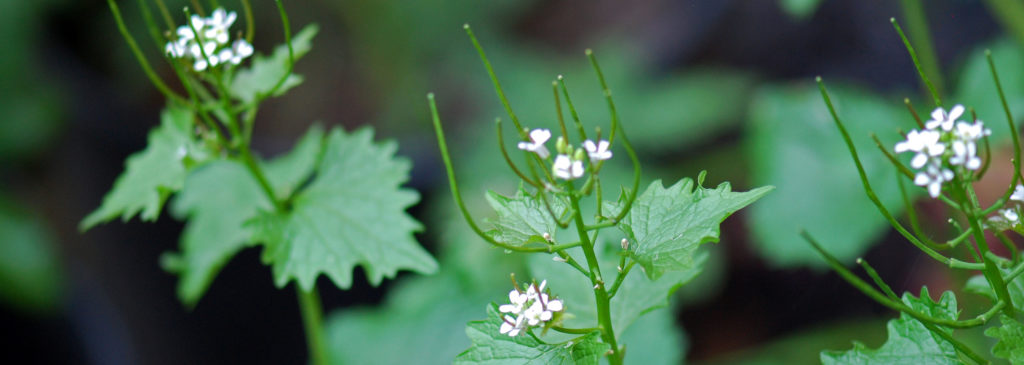Garlic mustard (Alliaria petiolata) is an increasingly invasive weed in our community. Native to central and western Europe, this fast-growing plant commonly invades sites such as parks, trails, roadsides, and streamsides. April is a great time to manage this important invasive weed on your property.
Sometimes referred to as Jack-by-the-hedge, garlic mustard is easily identified by crushing its leaves. When crushed, the leaves generally give off a strong garlic scent. While it is true that this weed is edible, it is generally avoided by most grazing animals. Adult plants form dense patches up to 3 feet in height at maturity. The plant produces white four-petaled flowers in the spring and has kidney-shaped, deeply scalloped leaves. It can grow in full sun to full shade, making it very adaptable to wherever its seed may land.
Why Should I Care About Garlic Mustard?
Garlic mustard spreads quickly! It displaces native vegetation needed by wildlife for food and habitat. Grazing animals avoid it, and its root system releases a chemical that keeps other plants, shrubs, and trees from establishing.
Additionally, each plant can produce up to 5000 seeds that can remain in the soil, waiting for an opportunity to sprout, for ten or more years. Once these seeds have exploded on your property, it is going to take some work to bring the infestation under control.
Seeds are typically spread by humans or animals who pick up the small seed on shoes, clothes, fur, or equipment. Care needs to be taken to thoroughly clean clothing and equipment after moving through infested areas to help prevent the spread of garlic mustard. It can take many years to bring it under control once it has gotten established. Early prevention saves both time and money!
How Can I Control Garlic Mustard?
Garlic mustard can be very difficult to control due to the large number of seeds it produces. Small patches can be controlled by pulling the adult plants before they begin to flower. Once plants begin flowering, be sure to bag and dispose of the plants as trash. Flowers from pulled plants CAN and WILL produce seed! When pulling garlic mustard, be sure to remove the entire taproot to prevent re-sprouting. Springtime is the best time to remove garlic mustard, while the soil is still soft from winter and spring rains.
For larger patches of garlic mustard, our WeedWise team recommends using an herbicide application in spring, followed by hand pulling in early summer before seeds develop. You can read more about best management practices for garlic mustard here.
Report garlic mustard!
Have you noticed invasive garlic mustard in your area? If so, please report your sightings to the District’s WeedWise program by giving us a call at 503-210-6000, or submit your information online to the Oregon Invasive Species hotline. Your help in identifying and reporting locations of garlic mustard in our community will provide early detection information to the experts working to stop the next invasion before it starts!

